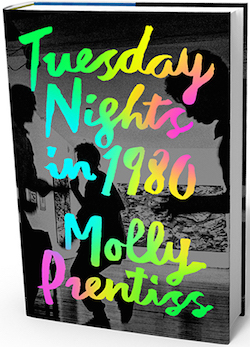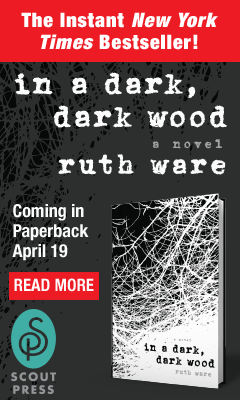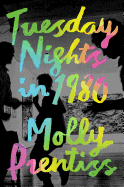Tuesday Nights in 1980
by Molly Prentiss
It is New Year's Eve, 1979. In Buenos Aires, a woman named Franca is raising her son alone. The country is in the midst of the turmoil called the Dirty War; kidnappings are on the rise, and Franca is frightened: she has been baking cakes for an underground group that records the names of the "disappeared." In New York, a man named James Bennett has had a harder time than most finding his way in life: his synesthesia always made him exceptionally strange, as he refers to colors, sounds and smells no one else sensed. But he's finally made it, as an art critic for the New York Times. Also in the city, Raul Engales works night and day at his art, painting in poached studio space at New York University, a school he does not attend. He knows his work is better than any of what's being sold in the big galleries. If he could only get someone important to look at it.
Molly Prentiss's striking first novel, Tuesday Nights in 1980, covers one year, from December 31, 1979, through the final days of 1980. Says an art dealer with more influence than she perhaps deserves: "I've always found Tuesdays so charming, haven't you? I do everything on Tuesdays." The action tends to take place on Tuesdays, which sounds like a cumbersome and effortful device, but in fact flows smoothly and almost invisibly, following the lives of a few individuals in a city and an art scene big enough to swallow them. Tuesday Nights in 1980 is a sweepingly large and profound story about art, love and actualization, cleanly and beautifully composed.
The lives of Engales and James form the two main threads of story, with their fortunes rising and falling as precipitously as anything in 1980s' New York. James's success is born of the impressions other people's work makes on him: de Goya and Picasso's blue period both sound a bold, steady drumbeat; Bill Rice gives him a "nocturnal mood" and a headache; the paintings of Louise Fishman smell strongly of shampoo. "He felt gushes of wind and crawling ants, tasted burnt sugar and gazed at skies' worth of stars." Marc Chagall's work gives him a hard-on. Writing these impressions for a public audience gives him immense satisfaction and a little money, and helps him to accumulate a legendary and sought-after collection of "the pieces that made him hear beautiful music." Meanwhile, Engales sees the glimmering beginnings of the attention his work deserves. He finds a community: the grouchy woman at his art studio, the fellow creatives at "the squat" where he spends his free time and finally, crucially, a muse. Lucy is an innocent from Idaho who believes in omens, who steps out of a taxicab into a world of promise and finds what she thinks she is looking for in the artist. Then James and Engales each suffer a drastic, shattering loss that changes their respective abilities to create. And a small boy from Argentina appears in their lives, offering new varieties of pain, love and responsibility.
Tuesday Nights in 1980 portrays the arts scene as inspired and genius, and fraught with tension between creativity and the question of "selling out." James's weird and enchanting perceptions allow Prentiss to paint the visual arts colorfully, as well as fragrantly, noisily, brilliantly, tenderly and roughly. A central theme is the beauty of damage. "Wounds and deformities and cracks and boils and stomachs: this was the stuff that moved Engales... He could hear his father saying: The scratches are what makes a life." This is not a concept invented by Prentiss, but her characters struggle with and embody it in moving, new ways.
While always told from a third-person perspective, the focus changes from chapter to chapter among Prentiss's diverse cast: primarily James, Engales and Lucy, but supported by a number of equally fascinating and colorful associates. James's wife, Marge, is a woman who presents to him as a deep and glorious red, whose own creative career has been sacrificed to enable his. Arlene is a curmudgeonly painter friend to Engales, given to unconventional sartorial choices: a "long fish skirt and a coat that was somehow both puffy and flowy" or "a flowy dress with an outrageous pattern on it... eccentric cowboy boots and a trench coat of sorts, with many, many pockets." Prentiss's talent for characterization is prodigious, and matched by her delightful turns of phrase. The art collector who loves Tuesdays has "the kind of hair that was popular that year, a curtain revealing only the first act of her face: a queenly nose, confusingly colored eyes (were they violet?), cheekbones for days" and "a voice as simultaneously regal and flighty as her hair." She laughs "like a pretty horse."
A plot with multiple storylines involving so many characters is easily followed, because the people and events who form them are so memorable--but not to the point of caricature. No, James Bennett and Raul Engales and the rest are only as bizarre as their time and place, which Prentiss evokes perfectly: SoHo on the brink of devastating gentrification; artistic genius on the brink of commercialization or self-destruction, or both; and the insane, everyday choices made by regular people seeking love, identity and community but fearing to make the wrong move. Tuesday Nights in 1980 is a beautiful, poetic novel of ambitiously profound considerations, a large-scale drama in a series of small, perfectly rendered moments. --Julia Jenkins








.jpg)
